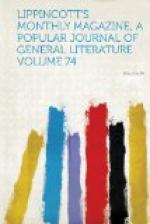A breadth of thirty feet will be left to the main promenades along and athwart, of fifteen feet to the principal ones on either side, and of ten feet to all the others. Narrow highways these for traversing the kingdoms of the world, but, combined, they nearly equal the bottom depth of the Suez Canal, very far exceed the five feet of the Panama Railway, and still farther the camel-track that sufficed a few centuries ago to link our ancestors to the Indies. The berths of the nations run athwartship, or north and south as the great ark is anchored. The classes of objects are separated by lines running in the opposite direction. Noah may be supposed to have followed some such arrangement in his storage of zoological zones and families. He had the additional aid of decks; which our assemblers of the universe decline, small balconies of observation being the only galleries of the Main Building. Those at the different stages of the central towers will be highly attractive to students who prefer the general to the particular, or who, exhausted for the time, retire to clear their brains from the dust of detail and muster their faculties for another charge on the vast army of art. From this perch one may survey mankind from China to Peru through “long-drawn aisles” flooded with mellow light, the subdued tones of the small surface that glass leaves open to the paint-brush relieved with a few touches of positive color to destroy monotony. These are assisted by the colored glass louvres, which have no other artistic merit, but serve, where they are placed over the side-entrances, to indicate the nation to whose department belongs that particular vomitorium.
Four miles of water- and drainage-pipe underlie the twenty-one and a half acres of plank floor in this building. The pillars and trusses contain thirty-six hundred tons of iron. The contract for it was awarded in July, 1874, and it was completed in eighteen months, being ready for the reception of goods early in January last. The cost was $1,420,000, and in mechanical execution the iron-, glass-and wood-work is pronounced fully equal to either of the British structures and superior to those of the Continent. In economy of material for producing a given result it is probable that the iron trusses and supports of the English buildings are as much excelled as the iron bridges of this country surpass those of Great Britain in the combination of lightness with strength. Our metal is better, and its greater cost has united with the scarcity of labor which so stimulated ingenuity in other departments of industry to enforce tenuity of form. Foreign engineers wonder that our viaducts stand, but somehow they do stand.




